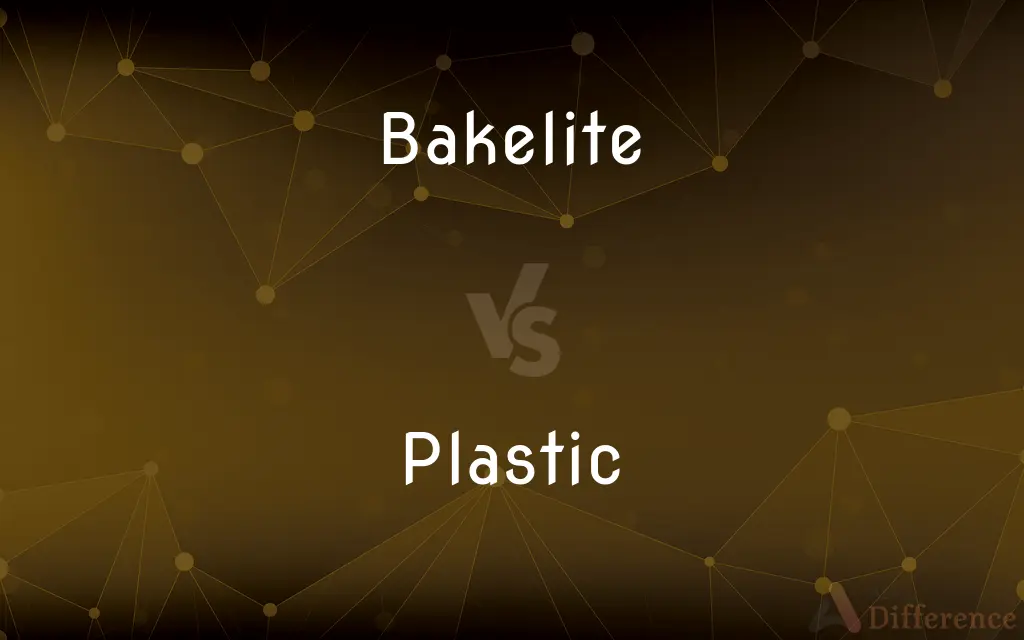Bakelite vs. Plastic — What's the Difference?
Edited by Tayyaba Rehman — By Fiza Rafique — Updated on September 26, 2023
Bakelite is an early synthetic plastic known for its electrical nonconductivity and heat resistance, while Plastic is a broad term for synthetic or semi-synthetic materials with malleability.

Difference Between Bakelite and Plastic
Table of Contents
ADVERTISEMENT
Key Differences
Bakelite and Plastic both fall under the category of polymers. However, Bakelite specifically denotes one of the earliest synthetic plastics, invented by Leo Baekeland in the early 20th century. Plastic, on the other hand, represents a vast array of synthetic or semi-synthetic malleable materials.
Bakelite is renowned for its unique properties such as electrical nonconductivity, heat resistance, and its hard, brittle nature. These attributes made Bakelite a popular choice for electrical insulators, radio and telephone casings, and various other applications. In contrast, Plastics encompass a vast range of materials, from soft and flexible (like polyethylene) to hard and rigid (like polystyrene).
The invention and rise of Bakelite marked the onset of the age of plastics. Its success illustrated the potential of synthetic materials. While Bakelite is a type of plastic, not all plastics are Bakelite. The term Plastic is more general, encompassing materials with diverse properties, applications, and chemical compositions.
The evolution of plastics after Bakelite led to the introduction of numerous other materials, some with properties surpassing those of Bakelite. This makes Plastic a more versatile term, accommodating everything from PET bottles to PVC pipes, while Bakelite has its specific set of applications and historical significance.
Comparison Chart
Nature
A specific type of early synthetic plastic.
A broad category of synthetic or semi-synthetic materials.
ADVERTISEMENT
Properties
Heat resistant and electrically nonconductive.
Varies; can be soft, hard, flexible, rigid, etc.
Invention
By Leo Baekeland in the early 20th century.
Numerous inventors; spans various materials and eras.
Applications
Electrical insulators, radio casings, etc.
Broad; everything from bottles to car parts.
Flexibility
Typically hard and brittle.
Varies; some are very flexible, others are rigid.
Compare with Definitions
Bakelite
Bakelite is one of the first synthetic plastics.
The radio from the 1940s was made of Bakelite.
Plastic
Plastic is a malleable synthetic or semi-synthetic material.
The bottle is made of plastic.
Bakelite
Bakelite was commonly used in the mid-20th century.
Grandma's old jewelry was made of Bakelite.
Plastic
Plastic materials are versatile.
Plastic can be molded into toys, containers, and more.
Bakelite
Bakelite is known for its electrical nonconductivity.
Bakelite was used for electrical switches due to its nonconductive nature.
Plastic
Plastics are a wide range of synthetic or semi-synthetic materials that use polymers as a main ingredient. Their plasticity makes it possible for plastics to be moulded, extruded or pressed into solid objects of various shapes.
Bakelite
Bakelite has a hard, brittle texture.
That Bakelite handle broke when it fell.
Plastic
A synthetic material made from a wide range of organic polymers such as polyethylene, PVC, nylon, etc., that can be moulded into shape while soft, and then set into a rigid or slightly elastic form
Mains pipes should be made of plastic or copper
Bottles can be made from a variety of plastics
Bakelite
Bakelite is heat resistant.
Bakelite handles on pans remain cool on the stove.
Plastic
Made of plastic
Plastic bottles
Bakelite
Polyoxybenzylmethylenglycolanhydride, better known as Bakelite ( BAY-kə-lyte; sometimes spelled Baekelite), was the first plastic made from synthetic components. It is a thermosetting phenol formaldehyde resin, formed from a condensation reaction of phenol with formaldehyde.
Plastic
(of a substance or material) easily shaped or moulded
Rendering the material more plastic
Bakelite
Alternative form of Bakelite
Plastic
Capable of being shaped or formed
Plastic material such as clay.
Bakelite
A thermosetting plastic used in electric insulators and for making plastic ware and telephone receivers etc.
Plastic
Relating to or dealing with shaping or modeling
The plastic art of sculpture.
Bakelite
A thermosetting plastic used as electric insulators and for making plastic ware and telephone receivers etc.
Plastic
Having the qualities of sculpture; well-formed
"the astonishing plastic beauty of the chorus girls" (Frank Harris).
Plastic
Giving form or shape to a substance
The plastic forces that create and wear down a mountain range.
Plastic
Easily influenced; impressionable
"The plastic mind of the bank clerk had been ... distorted by what he had read" (Rudyard Kipling).
Plastic
Made of a plastic or plastics
A plastic garden hose.
Plastic
(Physics) Capable of undergoing continuous deformation without rupture or relaxation.
Plastic
Capable of building tissue; formative.
Plastic
Able to change and adapt, especially by acquiring alternative pathways for sensory perception or motor skills. Used of the central nervous system.
Plastic
Marked by artificiality or superficiality
A plastic world of fad, hype, and sensation.
Plastic
(Informal) Of or obtained by means of credit cards
Plastic money.
Plastic
Any of various organic compounds produced by polymerization, capable of being molded, extruded, cast into various shapes and films, or drawn into filaments used as textile fibers.
Plastic
(Informal) A credit card or credit cards
Would accept cash or plastic in payment.
Plastic
A synthetic, solid, hydrocarbon-based polymer, whether thermoplastic or thermosetting.
Plastic
Credit or debit cards used in place of cash to buy goods and services.
Plastic
Insincerity; fakeness, or a person who is fake or arrogant, or believes that they are better than the rest of the population.
Plastic
An instance of plastic surgery.
Plastic
(obsolete) A sculptor, moulder.
Plastic
(archaic) Any solid but malleable substance.
Plastic
Capable of being moulded; malleable, flexible, pliant.
Plastic
Producing tissue.
Plastic
(dated) Creative, formative.
Plastic
(biology) Capable of adapting to varying conditions; characterized by environmental adaptability.
Plastic
Of or pertaining to the inelastic, non-brittle, deformation of a material.
Plastic
Made of plastic.
Plastic
Inferior or not the real thing.
Plastic
Fake; insincere.
Plastic
Having the power to give form or fashion to a mass of matter; as, the plastic hand of the Creator.
See plastic Nature working to his end.
Plastic
Capable of being molded, formed, or modeled, as clay or plaster; - used also figuratively; as, the plastic mind of a child.
Plastic
Pertaining or appropriate to, or characteristic of, molding or modeling; produced by, or appearing as if produced by, molding or modeling; - said of sculpture and the kindred arts, in distinction from painting and the graphic arts.
Medallions . . . fraught with the plastic beauty and grace of the palmy days of Italian art.
Plastic
A substance composed predominantly of a synthetic organic high polymer capable of being cast or molded; many varieties of plastic are used to produce articles of commerce (after 1900). [MW10 gives origin of word as 1905]
Plastic
Generic name for certain synthetic or semisynthetic materials that can be molded or extruded into objects or films or filaments or used for making e.g. coatings and adhesives
Plastic
Used of the imagination;
Material...transformed by the plastic power of the imagination
Plastic
Capable of being molded or modeled (especially of earth or clay or other soft material);
Plastic substances such as wax or clay
Plastic
Capable of being influenced or formed;
The plastic minds of children
A pliant nature
Plastic
Plastic is derived from polymers.
The plastic chair consists of polymer chains.
Plastic
Plastic is ubiquitous in modern life.
Almost everything in the room contains some form of plastic.
Plastic
Plastic's properties can vary widely.
This plastic is soft and stretchy, while that one is hard and brittle.
Common Curiosities
Who invented Bakelite?
Bakelite was invented by Leo Baekeland in the early 20th century.
Are plastics harmful to the environment?
Many plastics are non-biodegradable, causing environmental concerns when not properly recycled.
Why was Bakelite so popular in the past?
Bakelite's heat resistance and electrical nonconductivity made it popular for various applications.
Are all plastics heat resistant like Bakelite?
No, the properties of plastics vary; not all are heat resistant like Bakelite.
What are some common types of Plastic?
Common types include polyethylene (PE), polypropylene (PP), and polyvinyl chloride (PVC).
Is Bakelite a type of Plastic?
Yes, Bakelite is one of the earliest forms of synthetic plastic.
Is the word 'plastic' derived from its malleability?
Yes, "plastic" originates from the Greek word "plastikos," meaning "capable of being shaped."
Why is there concern over plastic usage today?
Environmental and health concerns arise from plastic waste and potential chemical leaching.
Did Bakelite pave the way for modern plastics?
Yes, Bakelite's success led to increased interest and development in the field of plastics.
Is Bakelite still in use today?
While not as common as in the past, Bakelite still has some niche applications.
Can Bakelite be recycled like other plastics?
Bakelite is harder to recycle than many modern plastics due to its composition.
Are there alternatives to plastic?
Yes, materials like glass, metal, and bioplastics serve as alternatives in various applications.
Are plastics derived from oil?
Yes, most synthetic plastics are derived from petrochemicals, which come from oil.
What is the primary component of Bakelite?
Bakelite is primarily made from phenol formaldehyde resin.
How are plastics classified?
Plastics can be classified based on origin (synthetic/semi-synthetic), polymer structure, or properties.
Share Your Discovery

Previous Comparison
Fedora vs. Homburg
Next Comparison
Drawing vs. IllustrationAuthor Spotlight
Written by
Fiza RafiqueFiza Rafique is a skilled content writer at AskDifference.com, where she meticulously refines and enhances written pieces. Drawing from her vast editorial expertise, Fiza ensures clarity, accuracy, and precision in every article. Passionate about language, she continually seeks to elevate the quality of content for readers worldwide.
Edited by
Tayyaba RehmanTayyaba Rehman is a distinguished writer, currently serving as a primary contributor to askdifference.com. As a researcher in semantics and etymology, Tayyaba's passion for the complexity of languages and their distinctions has found a perfect home on the platform. Tayyaba delves into the intricacies of language, distinguishing between commonly confused words and phrases, thereby providing clarity for readers worldwide.














































